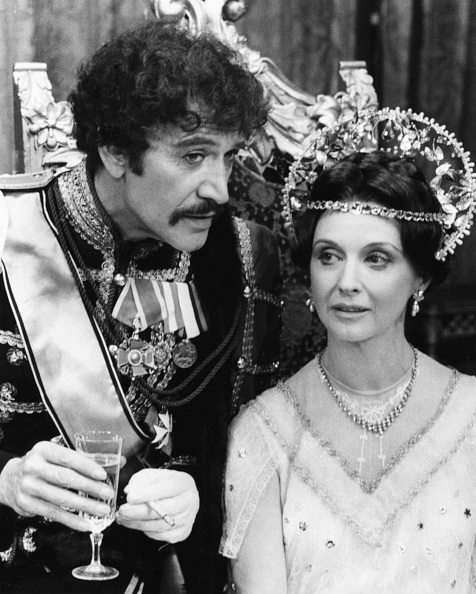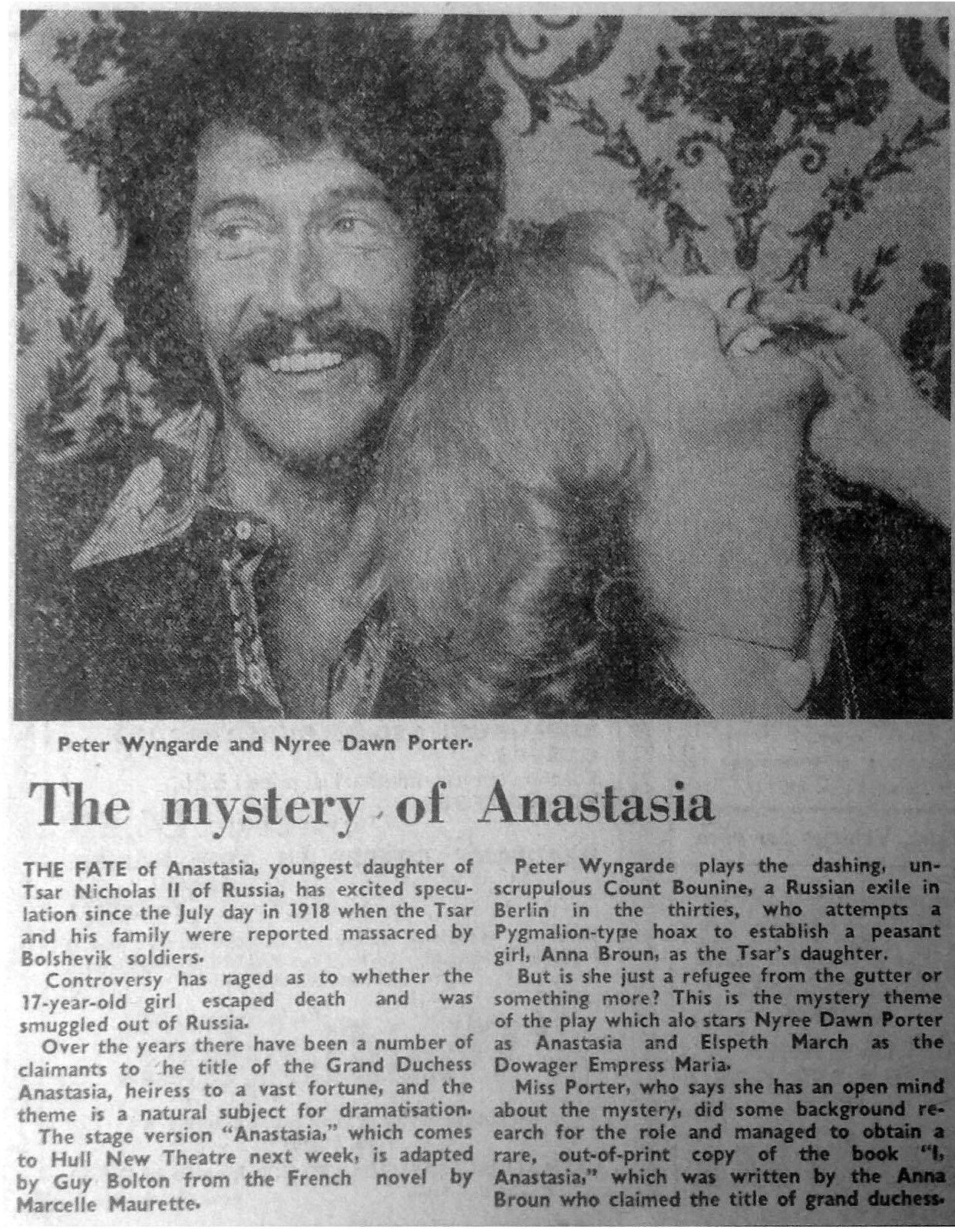
Presented by Ashway Productions Ltd., in association with The Laurence Parness Organisation Ltd. British tour, Summer/Autumn 1976
Character: Prince Bounine
The action takes place in the Reception Room of Prince Bounine’s mansion in the outskirts of Berlin.
- Act I: A January Evening
- Act II: An afternoon one weeks later
- Act III: An afternoon two weeks later
The play tells the story of a group of unscrupulous Russian exiles: the Tzar’s former aide-de-camp Prince Bounine (Peter Wyngarde) – artist Piotr Petrovsky (David Griffin), and banker, Boris Adreivich Chernov (David Nettheim), decide to exploit Anna Broun (Nyree Dawn Porter), when she claims to be Princess.
The men decide to form a consortium to raise funds amongst the exiled White Russian community to provide backing for ‘Anastasia’ to reclaim a inheritance of over £3,000,000, which the syndicate plan to share between themselves. Their main concern is to convince the Court in Exile – and especially the Dowager Empress Marie (Elspeth March), the Tsar’s mother.

As speculation concerning the Princess begins to spread across Europe, there is no shortage of subscribers willing to aid the conspirators and the young woman who, there is little doubt, bears a striking resemblance to the long-lost Anastasia.
Right: Peter as Prince Bounine with Nyree Dawn Porter as Anastasia
Matters take an unexpected turn when the Prince Bounine and his accomplices begin to realise that Anne might actually be the real deal.
Obviously traumatised by the machinations of the three accomplices, ‘Anastasia’ reaches out to to in a catatonic trance the Dowager Empress who, aware of the men’s deception, answers with her own yearnings and wishful thinking. Self and reality are whatever we want them to be, it would seem, and all untrustworthy, unsound and brittle.
The Anastasia Enigma
In 1918, the Grand Duchess Anastasia Nikolaevna of Russia and the rest of the ruling Romonov family, were reported massacred by Bolshevik Bolshevik Red Guards in Ekaterinburg, and controversy thereafter raged as to whether the 17-year-old Duchess escaped death and was smuggled out of Russia.
The tragic events leading up to the assassination of the last Tsar of Russia are well recorded in history. The young Tsarevich Alexis – only son of the Tsar Nicholas and the Empress Alexandra, was an haemophiliac; a genetic disease inherited through the line of his Great Grandmother, Queen Victoria, and his suffering caused the Empress to turn to Rasputin; a wandering holy man. Through his hypnotic powers, Rasputin could elevate her son’s pain. The tremendous hold that the mystic had over the Empress was one of the major factors that led to the Revolution. The Tsar was naïve, ill-advised and believed wholeheartedly in the autocracy. When the country asked for reform and a sharing of the Imperial power with a more responsible government, the Tsar, influenced by Alexandra and Rasputin, refused and revolution was inevitable.
The Revolution in 1917 culminated in the downfall of the fabulously wealthy Romanov dynasty. In 1918 Nicholas and Alexandra, their daughters Olga, Tatiana, Marie and Anastasia, and the Tsarevich Alexis were imprisoned at Ekalerinburg. It is reported that on the night of July 16th the entire family, along with four retainers and a pet spaniel, were shot and bayonetted to death and their bodies disposed of in a disused mine shaft.

However, over the years there have been a number of claimants to the title of the Grand Duchess Anastasia; heiress to a vast fortune, and the rumours persist that the young Anastasia miraculously escaped the massacre and was smuggled out of Russia by sympatisers. One of the most famous of these was Anna Broun, also known as Anna Anderson, who was the only woman who tried legally to establish herself as the legitimate heiress to the Romanov legacy. her case was finally dismissed in the German courts in 1967.
Nyree Dawn porter who played Anna Broun in this play, said at the time that she had an open mind on the subject. During her research for the role she’d come across an out-of-print book entitled, ‘I Am Anastasia’, that had been written by Broun. She said she found the story intriguing. “When I first heard the story, I thought she must’ve been a charlatan,” Ms Porter said. “Then I read the book and found myself completely bemused, There are so many factors to think about. Anna had a schizophrenic side to her character – she had to find herself. She’s not nice, but she wasn’t insane. And is she wasn’t Anastasia it was a long time to live a lie. The play is very close to what really happened. The characters are fact, though some have been given different names and a certain amount of dramatic licence has been taken”.
Peter, who portrayed Prince Bounine in the play, shares Ms Porter’s views on Anna Broun. “I haven’t got an answer to it at all,” he says. “But I’m fascinated by certain aspects of the story – the fact, for instance, that Anna could not or would not speak Russian when she was first found., though it later turned out that she spoke the language fluently. Also that the claims for the Tsar’s money were suddenly dropped and nobody has made a claim since, even though there’s a great deal of money involved. In 1912, the Tsar was the richest man in the world”.
Such an intriguing and romantic mystery is an obvious subject for dramatization. A film version of ‘Anastasia’ was made in 1956 starring Ingrid Bergman and Yul Brynner as Anna and prince Bounine, and in 1971, Kenneth McMillan created a full-length ballet about Anastasia for Lynn Seymour and the Royal Ballet. More recently, a musical version became a box office hit on Broadway. This particular play was adapted by Guy Bolton from the French novel by Marcelle Maurette.
At the time that this play was touring the UK, there was a chance that the Anastasia legend might have a sequel. In ‘The File on the Tsar’ (Gollancz) – a book published in the mid-1970’s by Tom Mangold and Anthony Summers, new evidence was brought to light, suggesting that other members of the Romanov family may’ve survived. One fact is certain – the Anastasia enigma will continue to be of enduring appeal and interest.
___________________________________________________

| Actor David Nettheim on working with Peter in ‘Anastasia’: “Peter Wyngarde was really an outrageous character. You couldn’t believe the clothes he wore. We played a West End season at the Cambridge Theatre. He played the principal lead character, which Yul Brynner played and which I played before Yul Brynner at the very first season – at four days’ notice I might add, but that’s another story. Peter was flamboyant and didn’t like the designs for his costumes when he saw them on paper. He didn’t say anything, went off and engaged a designer to design all his uniforms, which looked over-the-top!” Actually, both Peter’s uniform, and the costumes worn by Elspeth March, were designed by Alan Sievewright! And you wonder how these ridiculous stories begin…. |

| POINT OF INTEREST… Peter had previously worked with Nyree Dawn Porter and Elspith March in ‘The Duel’ at the Duke of York’s, London, in 1968, and with Ms March in ‘Underground’ – National British tour, 1983. |
© Copyright The Hellfire Club: The OFFICIAL PETER WYNGARDE Appreciation Society: https://www.facebook.com/groups/813997125389790/


2 thoughts on “REVIEW: Anastasia”